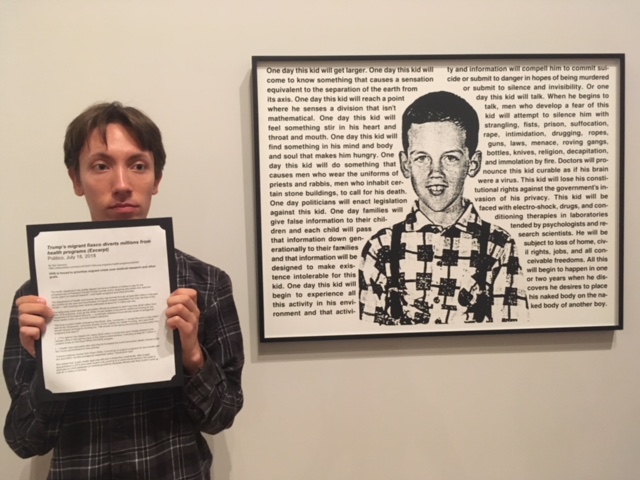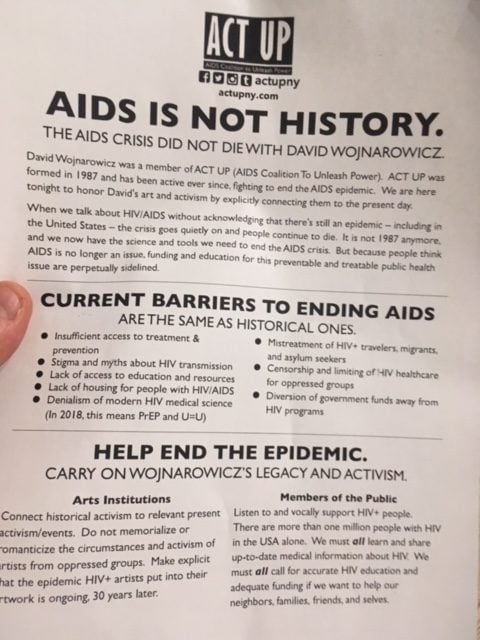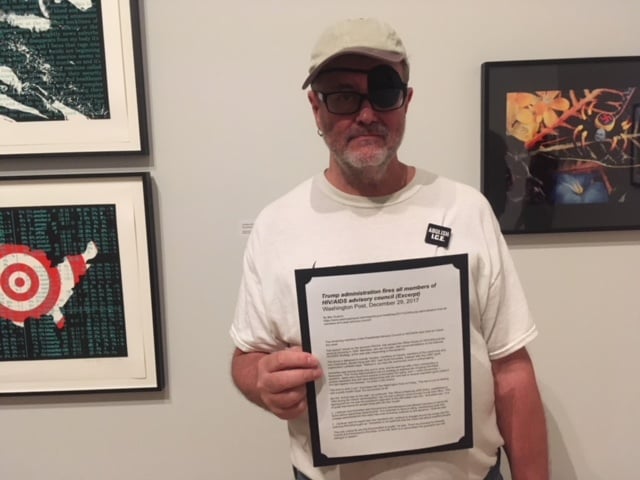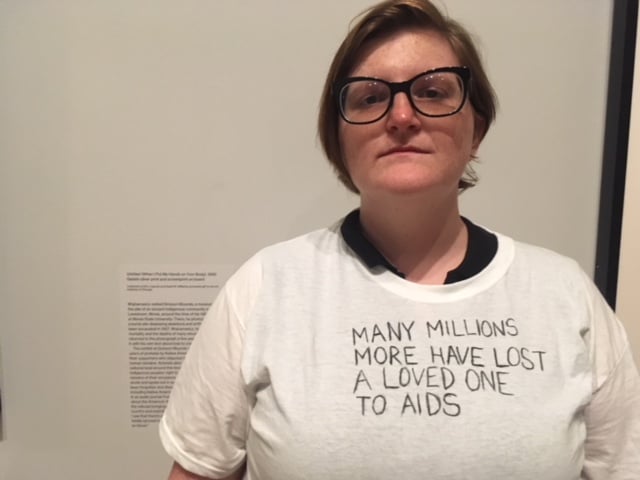Art World
‘AIDS Is Not History’: ACT UP Members Protest the Whitney Museum’s David Wojnarowicz Show, Claiming It Ignores an Ongoing Crisis
About a dozen members of the AIDS activist organization descended on the New York museum.

About a dozen members of the AIDS activist organization descended on the New York museum.

Sarah Cascone

Protesters from the AIDS Coalition to Unleash Power, better known as ACT UP, targeted the Whitney Museum of American Art’s critically acclaimed David Wojnarowicz retrospective in New York on Friday night, accusing the show of historicizing the still-ongoing AIDS epidemic.
About a dozen members of ACT UP’s New York chapter were present for the protest, which involved holding up recent news articles about HIV and AIDS as contextualizing “wall text” next to the works on view. Wojnarowicz was a member of ACT UP until his death at 37 in 1992. As an outspoken AIDS activist, he often used his work to highlight the social injustices faced by those infected with HIV.
“AIDS is not history. The AIDS crisis did not die with David Wojnarowicz,” reads a mission statement displayed by protesters at the museum. “We are here tonight to honor David’s art and activism by explicitly connecting them to the present day. When we talk about HIV/AIDS without acknowledging that there’s still an epidemic—including in the United States—the crisis goes quietly on and people continue to die.”

The AIDS Coalition to Unleash Power, or ACT UP, is protesting the current Whitney Museum of American Art exhibition “David Wojnarowicz: History Keeps Me Awake at Night,” as they feel the show casts the AIDS epidemic in a historic light. Photo courtesy of Alan Timothy Lunceford-Stevens.
“We agree with ACT UP that the AIDS crisis is not over,” a Whitney representative told artnet News in an email. “As a museum dedicated to the art of the United States, we are adamant about making sure the ongoing history of the AIDS crisis figures centrally in American history. This historical work doesn’t just stay in the past; the hope is that it informs present and future action.”
“The work of David Wojnarowicz, as one of the exhibition’s wall texts reads, ‘concerns itself with the mechanisms, politics, and manipulations of power that make some lives visible and others not. The will to make bodies present—the compulsion to clear a space for queer representations not commonly seen through language and image—was threaded throughout his work,'” the representative continued. “Following Wojnarowicz’s example, this is also the work the museum is trying to do.”
Alan Timothy Lunceford-Stevens, a long-term HIV survivor who personally knew Wojnarowicz, was one of the protesters at the museum. At the height of the AIDS crisis, in the late ’80s and early ’90s, “we had people dying every fucking week. We had 700, 800 members in ACT UP New York—people were fighting for their lives,” he recalled. “Robert Mapplethorpe was a friend of mine. Keith Haring was a friend of mine.”
ACT UP’s issue with the exhibition starts with the title, “David Wojnarowicz: History Keeps Me Awake at Night.”
“We’re in 2018 and AIDS is still killing people,” said Lunceford-Stevens, who has been a member of ACT UP since 1987, the year it was founded. “One ACT UP member carried a sign for the transgender woman who was in ICE jail in Texas. They didn’t give her [AIDS] meds and she died. And that’s murder!”

Alan Timothy Lunceford-Stevens from the AIDS Coalition to Unleash Power, or ACT UP, protesting at the Whitney Museum of American Art exhibition “David Wojnarowicz: History Keeps Me Awake at Night.” Photo courtesy of Alan Timothy Lunceford-Stevens.
Adding fuel to the protesters’ fire, the Trump Administration has effectively shuttered two federal bodies created to address the AIDS crisis. All 10 staff members of the Presidential Advisory Council on HIV/AIDS were fired in December, and there have been no replacements named. Similarly, the Office of National AIDS Policy, founded in 1993 as part of the Domestic Policy Council, was shut down following Trump’s inauguration.
Along with fellow protesters, Lunceford-Stevens spent three or four hours at the Whitney on Friday, standing in front of one of Wojnarowicz’s artworks and holding up a printed article from the Washington Post about the termination of the advisory council’s staff.
“Trump has no one directing him on AIDS policy procedure treatment or care—nor does he want it,” Lunceford-Stevens said. “You can look at Republican presidents and Democratic presidents. You’ll see that Trump is not following anybody’s mold. He’s got a bulldozer and that’s how he’s doing away with people who are marginalized, people who are not white and rich, or whatever you want to call the one percent.”

A protester from the AIDS Coalition to Unleash Power, or ACT UP, at the Whitney Museum of American Art exhibition “David Wojnarowicz: History Keeps Me Awake at Night.” Photo courtesy of Alan Timothy Lunceford-Stevens.
ACT UP is holding a meeting tonight to draft an open letter to the Whitney regarding the exhibition and how it might better educate its visitors about AIDS. “I think they could reach out to ACT UP, and we could provide information about the current situation and what we are working on to display at the museum,” Lunceford-Stevens said.
For its part, the Whitney is “open to hearing [the protesters’] concerns,” according to the museum’s representative. The institution is “actively studying” ways to add new wall text to the exhibition that highlights relevant, present-day art activism connected to the AIDS crisis and that “thanks ACT UP for the work they do—and have done—to place HIV and AIDS in the forefront of our political and cultural thinking,” the representative said.
ACT UP also hopes to encourage the museum to donate a portion of the profits from the sale of tickets, exhibition catalogues, and Wojnarowicz-related merchandise to AIDS-related nonprofits.
“As a nonprofit with an artistic and educational mission, our main objective isn’t revenue. The mission is to show the most important, compelling, and challenging artists of our time,” the museum’s representative noted. “The Whitney Museum is committed to exhibiting the work of artists who, like Wojnarowicz, make space for queer representations.”
For ACT UP, those representations are important, but they aren’t enough. “The danger is when you look right now at young people, they think AIDS is over with. They don’t think anyone is living with HIV. They go to the museum and they see it as art—they don’t see AIDS as an urgent problem,” Lunceford-Stevens said. “It could be that we have David Wojnarowiczes today who are dying. We want to protect people from HIV, and we want to care for those who have HIV.”
“David Wojnarowicz: History Keeps Me Awake at Night” is on view at the Whitney Museum of American Art, 99 Gansevoort Street, New York, July 13–September 30, 2018.